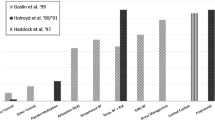Abstract
This follow-up study 1 to 5 years after biofeedback therapy, involving 58 patients in six diagnostic groups (migraine headache, tension headache, mixed headache, chronic pain, anxiety, and essential hypertension), revealed that 86% of the patients who continued to practice relaxation techniques improved, while only 50% of those who had stopped practice improved (p=.04). Among the patients who improved, 91% had continued to practice and only 9% had stopped practice, while among the patients who did not improve, 63% had continued to practice and 36% had stopped practice. Patients who were practicing only “occasionally,” “as needed,” or “when stressed” improved as much as or more than those who practiced regularly and frequently (i.e., at least weekly): 89% versus 77% improved, respectively (p=n.s). There was no difference in the occurrence or frequency of relaxation practice between patients who have been out of therapy 3 to 5 years and those who completed therapy more recently, or between those who were in brief versus longer-term therapy. Although continued relaxation practice is significantly related to the maintenance of long-term improvement, a few patients manage to improve without it, or continue to practice yet relapse. Furthermore, it appears that only occasional relaxation practice after therapy is sufficient to maintain long-term therapeutic gains.
Similar content being viewed by others
References
Budzynski, T., Stoyva, J., Adler, C., & Mullaney, D. EMG biofeedback and tension headache: A controlled outcome study.Psychosomatic Medicine 1973,35 484–496.
Carrington, P., Collings, G., Benson, H., Robinson, H., Wood, L., Lehrer, P., Woolfolk, R., & Cole, J. The use of meditation-relaxation techniques for the management of stress in a working population.Journal of Occupational Medicine 1980,22 221–231.
Kondo, C., & Canter, A. True and false electromyographic feedback: Effect on tension headache.Journal of Abnormal Psychology 1977,86 93–95.
Reinking, R., & Hutchings, D. Follow-up to “Tension headaches: What form of therapy is most effective?”Biofeedback and Self-Regulation 1981,6 57–62.
Silver, B., Blanchard, E., Williamson, D., Theobold, D. E., & Brown, D. Temperature biofeedback and relaxation training in the treatment of migraine headaches: One-year follow-up.Biofeedback and Self-Regulation 1979,4 359–366.
Williams, P., Francis, A., & Durham, R. Personality and meditation.Perceptual and Motor Skills 1976,43 787–792.
Zuroff, D., & Schwarz, J. Effects of transcendental meditation and muscle relaxation on trait anxiety, maladjustment, locus of control, and drug use.Journal of Consulting and Clinical Psychology 1978,46 264–271.
Author information
Authors and Affiliations
Rights and permissions
About this article
Cite this article
Libo, L.M., Arnold, G.E. Relaxation practice after biofeedback therapy: A long-term follow-up study of utilization and effectiveness. Biofeedback and Self-Regulation 8, 217–227 (1983). https://doi.org/10.1007/BF00998852
Issue Date:
DOI: https://doi.org/10.1007/BF00998852



